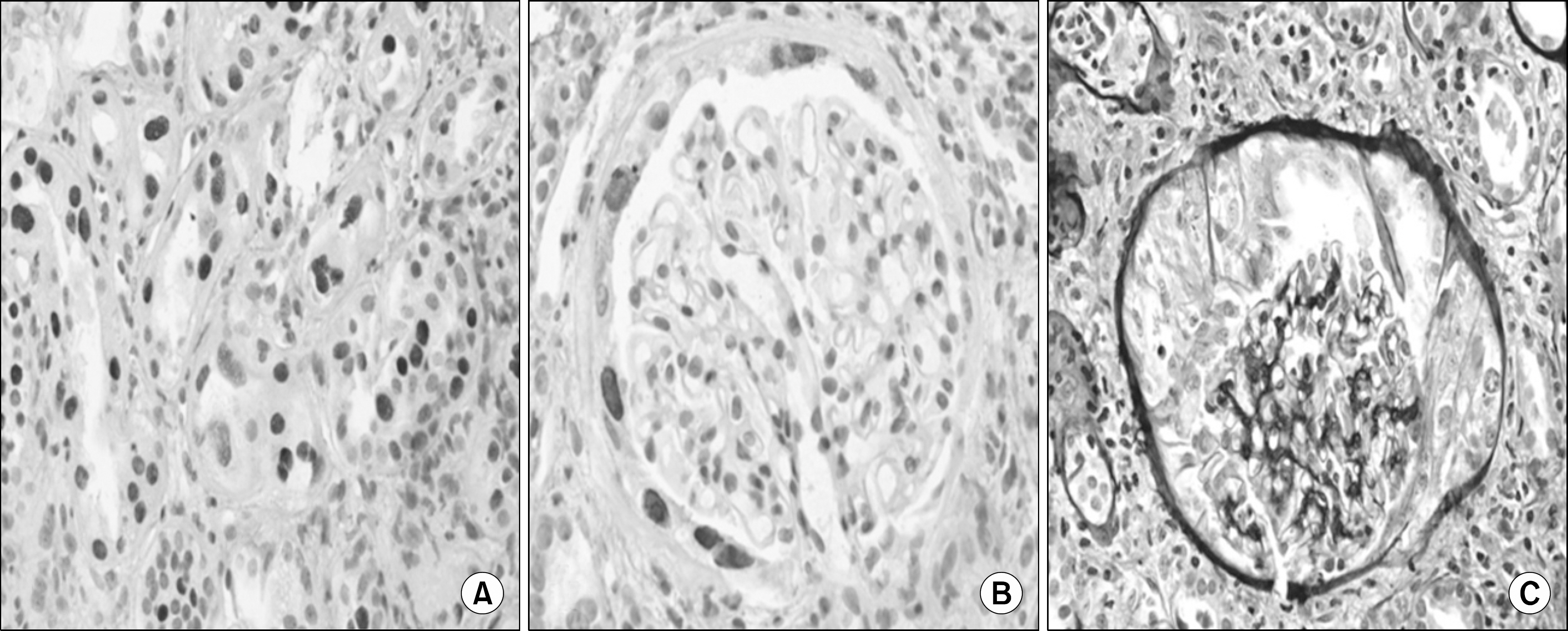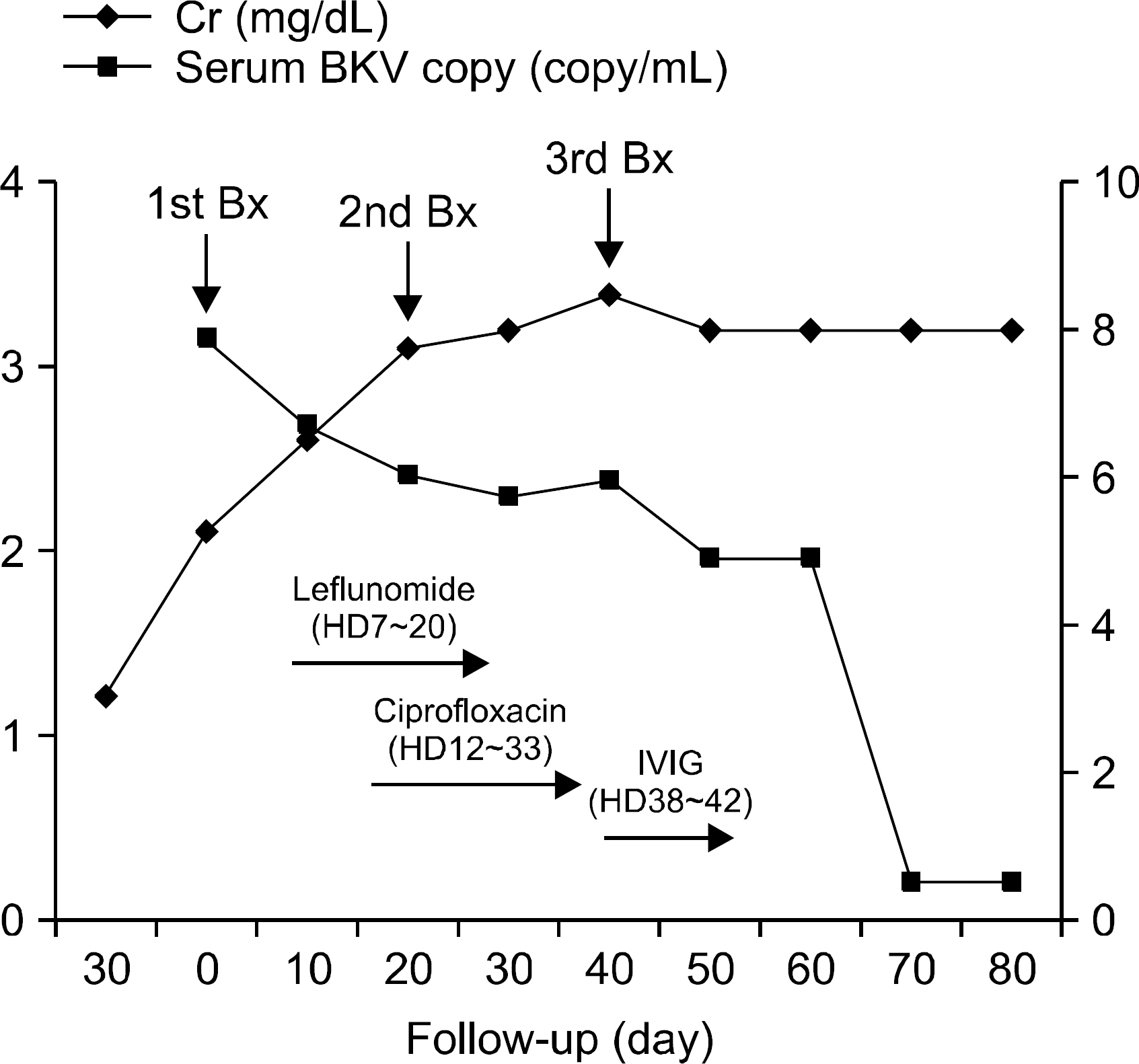J Korean Soc Transplant.
2016 Mar;30(1):35-37. 10.4285/jkstn.2016.30.1.35.
Severe Crescentic BK Nephropathy: A Case Report
- Affiliations
-
- 1Division of Nephrology, Department of Internal Medicine, Presbyterian Medical Center, Jeonju, Korea. kwangpmc@hanmail.net
- 2Department of Pathology, Division of Nephrology, Seoul St. Mary's Hospital, College of Medicine, The Catholic University of Korea, Seoul, Korea.
- 3Department of Internal Medicine, Seoul St. Mary's Hospital, College of Medicine, The Catholic University of Korea, Seoul, Korea.
- KMID: 2202626
- DOI: http://doi.org/10.4285/jkstn.2016.30.1.35
Abstract
- A 44-year-old man was admitted for evaluation of asymptomatic graft dysfunction. An allograft biopsy revealed diffuse interstitial infiltration of lymphocytes (i3) with moderate tubulitis (t3) and SV40-positive renal tubular epithelial cells. The patient was diagnosed with BK virus nephropathy, and immunosuppression was modified with discontinuing mycophenolate and reducing tacrolimus. Leflunomide treatment was also started simultaneously. However, serum creatinine increased to 3.0 mg/dL; therefore, the patient underwent a second allograft biopsy, in which the crescent was no longer evident but tubulitis (t2) and fibrosis (i2) persisted. On day 20, leflunomide was switched to ciprofloxacin due to leukopenia. The serum creatinine increased to 3.3 mg/dL, and the third biopsy showed slightly improved tubulitis and interstitial inflammation. We then administered an intravenous infusion of immunoglobulin. On day 70, the renal function was stable and the BK serum viral load was low, and the patient was discharged. This is a case of severe crescentic BK nephropathy with successful outcome treated with aggressive treatment and this method will be useful in renal transplant patients.
Keyword
MeSH Terms
Figure
Reference
-
1). Dall A., Hariharan S. BK virus nephritis after renal transplantation. Clin J Am Soc Nephrol. 2008. 3(Suppl 2):S68–75.2). Hariharan S. BK virus nephritis after renal transplantation. Kidney Int. 2006. 69:655–62.
Article3). Schwarz A., Linnenweber-Held S., Heim A., Brocker V., Rieck D., Framke T, et al. Factors influencing viral clearing and renal function during polyomavirus BK-associated nephropathy after renal transplantation. Transplantation. 2012. 94:396–402.
Article4). Celik B., Randhawa PS. Glomerular changes in BK virus nephropathy. Hum Pathol. 2004. 35:367–70.
Article5). Mazzucco G., Costa C., Bergallo M., Segoloni GP., Monga G. Severe crescentic BK virus nephropathy with favourable outcome in a transplanted patient treated with leflunomide. Clin Nephrol. 2008. 70:163–7.
Article
- Full Text Links
- Actions
-
Cited
- CITED
-
- Close
- Share
- Similar articles
-
- Crescentic Glomerulonephritis in a Patient with Rheumatoid Arthritis: A case report
- Expression of Adhesion Molecules in IgA Nephropathy, Diffuse Crescentic Glomerulonephritis, and Minimal Change Disease
- A Case of Concurrent Anti-Glomerular Basement Membrane Antibody Disease and Immunoglobulin A Nephropathy
- A case of crescentic immunoglobulin A nephropathy associated with Henoch-Schonlein purpura after kidney transplantation
- A Case of Crescentic IgA Nephropathy Associated with Alcoholic Liver Cirrhosis



